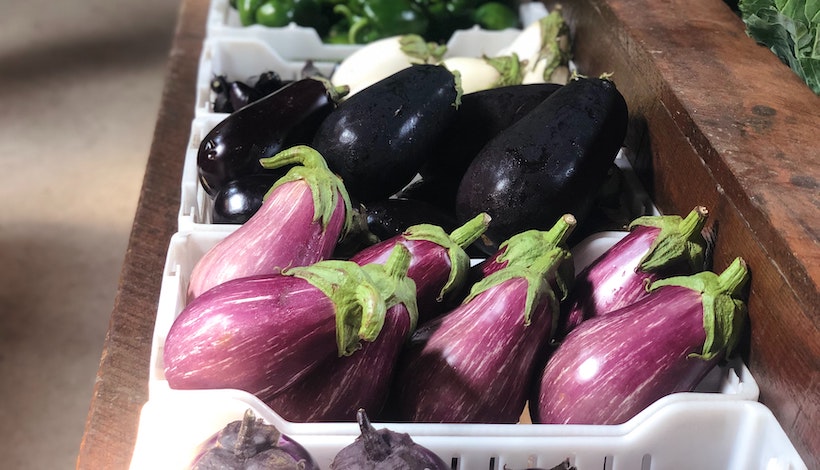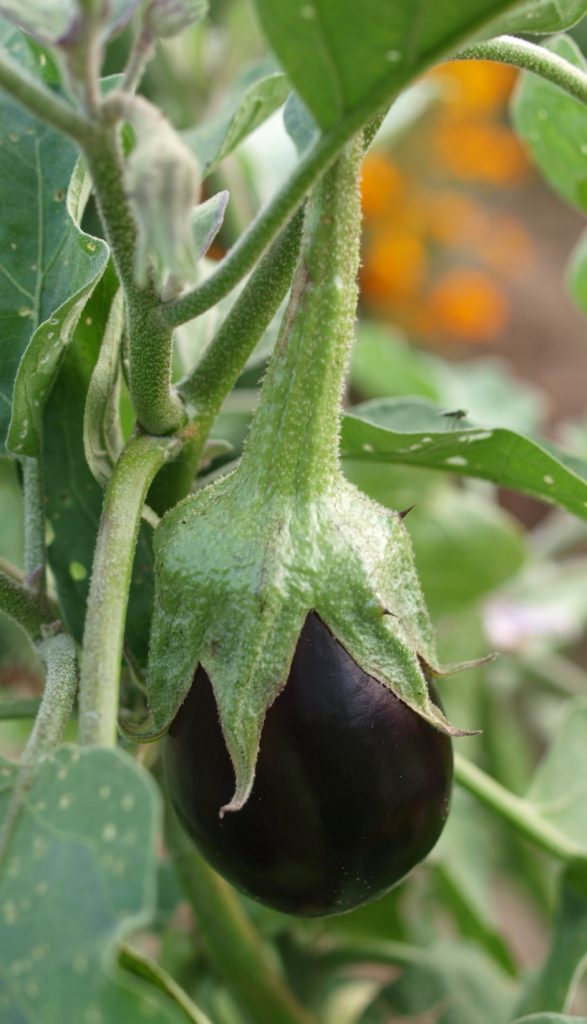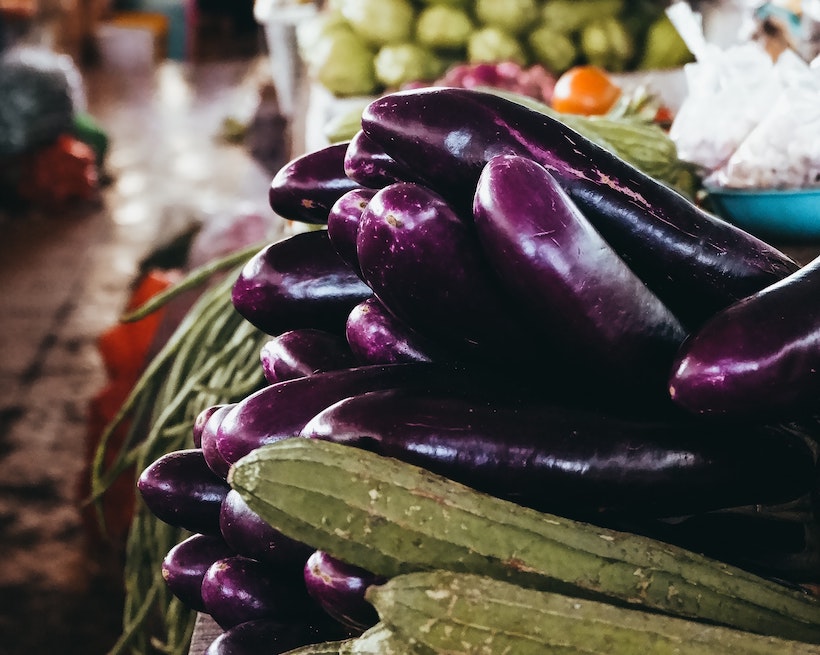Eggplants are an interesting (culinary) vegetable. Exotic seeming yet delicious, eggplants make their way into numerous dishes without always stealing the show.
It's got an interesting flavor profile and texture – and oh, wow, that color. Like its nightshades cousins, the tomato and tomatillo, it's also been unfairly labeled as poisonous.
What an intriguing food! I had to research more – in this post is everything I learned about the history of the eggplant.

Also known as aubergine or brinjal, the eggplant belongs to the nightshade genus Solanae with the aforementioned tomato and tomatillo and other plants such as tobacco, okra, potatoes, and the cape gooseberry. Technically a botanical fruit (it's a berry), Solanum melongena's savory flavor means it's treated as a culinary vegetable.
Like any other nightshade plants, eggplant also comes in a wide range of colors and sizes—while deep-purple skin is common, it's possible to find some that are black, red, green, or even yellow.
Eggplants thrive in hot climates and can grow about 12 inches in length and 2 inches in diameter. The seeds inside all the different eggplants are edible, making them easy to cook.
The name eggplant came from the Europeans in the 1750s because the fruit looks kind of like a goose egg. Some cultivars are white or light yellow and share the shape and size of eggs.
Eggplants are perennial plants best grown during the warm season. Given their subtropical and tropical heritage, they grow better in relatively high temperatures, like fellow nightshades peppers and tomatoes.
The ideal temperatures should be between 21 and 30°C (70 and 85°F), and they grow slowly during colder weather. Because eggplants require warm soil to grow, they're often purchased as transplants from 6 to 8 weeks old.
Like most fruits hailing in the nightshade family, the eggplant develops and hangs from the plant's branches, growing several feet in height.
The transplants are then taken to raised beds with compost manure or suitable fertilizer, which provides ideal growing conditions. After transplanting, you can harvest the eggplants at 65 to 85 days. However, when starting from a seed and not transplanting, expect to harvest them after 100 to 120 days.
Eggplants are an excellent source of nutritional value for your body.
The vitamin content of eggplants boasts Vitamins B1, B2, B3, B6, B12, K, and A is decent qualities. You'll also find significant amounts of magnesium, manganese, phosphorous, folic acid, and potassium.
On the nutrition side, they're reasonably low calorie – think ~ 30 calories for a cup. The only macronutrient it really provides in large quantity is around 8 grams of carbohydrate a cup – with around 3g as sugar and 2.5g as fiber.

Eggplants sometimes get a bad rap for their slightly bitter taste and soft texture. However, once you know how to prepare them, they are extremely satisfying.
Here are a few dishes to consider that are totally worth your time.
You no longer have to go to a five-star restaurant to have a taste of this world-class dish. The good thing about baba ganoush is that it is similar to preparing hummus, except swap the chickpeas for roasted eggplant.
You get to combine a slightly smoky, sweet, and soft-roasted eggplant with a paste of sesame seeds, spices, garlic, and fresh lemon juice. The taste is divine!
Fried eggplants are a straightforward preparation of the eggplant – simply season, pick an oil, and fry them up.
The end product is awesome, too: crispy, crunchy, and tasty. I suggest serving this snack with bread, fresh green beans, butter, and fresh tomatoes.
Ratatouille is a traditional French dish made with bell peppers, garlic, tomatoes, onions, zucchini, and eggplant. Bake the sliced veggies and simmer the sauce, and you have a delicious meal on your hands.

There's a bit of a dispute about where eggplants first arose. Oral tradition splits claims between India, South Asia, and Southwest Asia, while other tradition claims Africa.
To establish if the rumors had any basis, a group of researchers set out to study the eggplant's DNA and its different species. The lineage suggests that the eggplant originated in Africa and was domesticated two times – both in India and China.
So, at the end of the day, everyone has a claim!
The first recorded use of the eggplant was medical—some of the earliest texts, written about 100 BC, describe the medical benefits the eggplant has to offer.
The early adaptation of the eggplant in China was as a vegetable crop. However, for China to make this crop edible, it had to undergo a lengthy domestication process.
This process increased the weight and size of the eggplant. It also altered the peel color, flavor, and prickliness of the plant. That's not to say China didn't think it was a healer – in the 16th century, it was treated as a medicinal herb that could help cure ailments, like toothaches, abscesses, and intestinal hemorrhages.
In Persia, it was also used for medical purposes, like bile neutralization and ear disease treatment. The Persians also recommended that eggplants should be eaten cooked and ripe.
Domesticated in China and India, eggplants began to reach other parts of the world through trade. As with many plants and herbs first domesticated in Asia, the Silk Road is thought to be the main catalyst taking the eggplant to Europe.
Medieval adoption of the eggplant wasn't smooth in the slightest (just like with the tomato).
One of the most troublesome viewpoints? Many countries believed the eggplant was poisonous. Europe had the poisonous belladonna and the slightly less poison Mandrake – both enough to raise suspicions of a new crop. Scholars in the 12th century also recorded that it recorded feelings of anger.
During the Renaissance, the eggplant's increase in popularity was quite interesting.
It was during this period the plant was thought to have aphrodisiac properties. It was also believed to cause insanity primarily because it contained solanine (more on that in a bit).

Coming out of the East, and owing to its relationship to the Mandrake and Belladonna, the eggplant inspired many rumors. Alternatively known as poison and medicine and an aphrodisiac, it's hard to keep up with the facts.
Despite becoming a popular plant in China and India, the Persians initially gave the eggplant a bad reputation.
One of the first times it was mentioned in the Middle East was by Persian scholar Al-Razi, who compared the eggplant's color to gum disease in his book! Not a great start for the eggplant, and it definitely gained some negative associations from the label.
The Italians and Greeks gave the eggplant the name "mad apple," as they believed it could cause insanity (the tomato sometimes shared the nickname). Some scholars even theorized that the plant could cause numerous health problems, everything from leprosy to pimples.
However – we know now that it's a pretty safe plant. The flowers, leaves, and stems do contain solanine (don't eat them!) but prepared well, there's little risk to eggplant.
According to a study published in the New England Journal of Medicine in 1993, eggplants had the highest nicotine levels compared to other vegetables. However, the amount of nicotine present was minimal on a relative scale, as you'd have to eat 20 to 40 pounds(!) of eggplants to have the same effects as smoking a cigarette.
Across Europe, Asia, and Europe in the 16th century, it was assumed that this plant had aphrodisiac properties. Its suggestive shape also made it a phallic symbol: ?
This symbol made the eggplant receive several nicknames like an "ignoramus" or a "dunce" in Provencal France. Fast forward to the 21st century; the eggplant has become a popular emoji with social media users using it similarly – it's true, what's old is new again.
Many scholars, especially European scholars in the 12th century, believed that the eggplant was deadly. This myth was primarily adapted because of the plant's close relation to the nightshade family's Mandrake and Belladonna
Other safe plants in this family are tomatoes, potatoes, and bell peppers.
While bell peppers and potatoes avoided the taint, tomatoes and eggplants got painted with the poisonous label.
While tomato was dangerous, it wasn't because of the vegetable – tomato's acidity unlocked the lead from pewter plates, a hallmark of the upper class's dining rooms. Eggplants are more hit and miss – they are pretty high in histamine – which can upset sensitive digestion – and the waxy coating can cause contact dermatitis. But for most groups, they're both fine to eat.

So there you have it, the history of the eggplant. It was once just as misunderstood as the tomato – but luckily for our taste buds, humans overcame that early fear.
So eat up! It's delicious in a dish or as the star of the show. Fried, baked, or otherwise prepared – it's hard to go wrong with the eggplant.
OKra is not in the nightshade family. It is in the Mallow family.